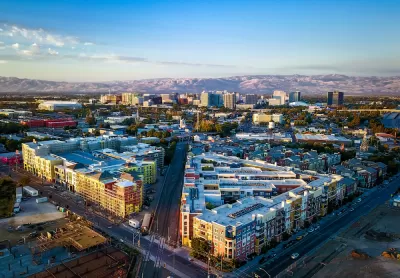Given that 97 percent of California cities aren't meeting their housing targets, SB 35, last year's landmark "by-right" housing bill, now applies to projects that contain varying amounts of affordable units.

As of 2012, California had 482 cities and 58 counties for a total of 540 local jurisdictions. How many of them have met their state-mandated requirement to provide both affordable and above moderate income, or market-rate housing, as determined by their Regional Housing Needs Assessment (RHNA)?
According to the California Department of Housing and Community Development (HCD), only 13, listed on the first page of their "SB 35 Statewide DeterminationSummary [pdf]" and further down in this post, for the 2016 reporting period. SB 35 refers to the landmark "by-right" housing bill authored by Sen. Scott Wiener (D-San Francisco) signed into law by Gov. Jerry Brown (D) along with 14 other housing bills.last September.
"SB 35 aims to make the permitting process faster and less cumbersome in those areas, with the hope of boosting the housing supply and stabilizing soaring housing costs over time," reports Katy Murphy for the East Bay Times on Feb. 1.
As for the remaining 97.6 percent of jurisdictions, they "are subject to at least some form of SB 35 streamlining," according to HCD. Stated differently, they "will now lose the ability to reject certain types of development projects" per the guidelines laid out in the legislation, writes Murphy.
“When 97 percent of cities are failing to meet their housing goals,” the bill’s author, Sen. Scott Wiener, D-San Francisco, said in a statement Thursday, “it’s clear we need to change how we approach housing in California.”
Unlike an even more controversial housing bill that the senator authored this year, SB 35 doesn't override a city's zoning rules.
It applies only to projects that comply with a city’s zoning rules, pay the prevailing wage, and ensure that at least 10 percent of the new units are affordable, or priced below market rate. (The prevailing-wage requirement only applies to projects with more than 10 units.)
Murphy goes on to describe the state guidelines for development contained in the Regional Housing Needs Allocation process, which many describe as 'broken.'
Critics say the state lacks power to enforce the guidelines, however, and many cities lobby to have their goals reduced, or ignore them altogether. Wiener has a pending proposal, Senate Bill 828, to change how those numbers are set. [SB 828 is one of a package of three "housing-first" bills authored by Wiener.]
It should be noted that the housing requirement is for planning, not building, as Foster City Councilman Herb Perez told Liam Dillion of the Los Angeles Times last June in a post on the shortcomings of the RHNA process.
"We have no intention of actually building the units," he told Dillon. Ironically, Foster City met their housing requirements (see below).
For cities and counties not part of the "lucky 13":
- Beverly Hills, Los Angeles County
- Carpinteria, Santa Barbara County
- Corte Madera, Marin County
- Foster City, San Mateo County [see note above from Councilman Perez]
- Hillsborough, San Mateo County
- Lemon Grove, San Diego County
- Napa County
- San Anselmo, Marin County
- San Fernando, Los Angeles County
- San Luis Obispo, San Luis Obispo County
- Santa Barbara County
- Sonoma County
- West Hollywood, Los Angeles County
Find your California city and county on the two SB 35 Statewide Determination Summary lists [pdf] that apply toward:
- When jurisdictions have insufficient progress toward their Above Moderate income RHNA and/or have not submitted the most recent Annual Progress Report (2016), these 378 jurisdictions are subject to SB 35 (Chapter 366, Statutes of 2017) streamlining for proposed developments with at least 10% affordability.
- When jurisdictions have insufficient progress toward their Lower income RHNA (Very Low and Low income), these 148 jurisdictions are subject to SB 35 (Chapter 366, Statutes of 2017) streamlining for proposed developments with at least 50% affordability.
Hat tip to Steve Birdlebough.
FULL STORY: Housing shortage: New report shows how California cities and counties stack up

Alabama: Trump Terminates Settlements for Black Communities Harmed By Raw Sewage
Trump deemed the landmark civil rights agreement “illegal DEI and environmental justice policy.”

Planetizen Federal Action Tracker
A weekly monitor of how Trump’s orders and actions are impacting planners and planning in America.

The 120 Year Old Tiny Home Villages That Sheltered San Francisco’s Earthquake Refugees
More than a century ago, San Francisco mobilized to house thousands of residents displaced by the 1906 earthquake. Could their strategy offer a model for the present?

San Francisco Opens Park on Former Great Highway
The Sunset Dunes park’s grand opening attracted both fans and detractors.

Oregon Legislature to Consider Transit Funding Laws
One proposal would increase the state’s payroll tax by .08% to fund transit agencies and expand service.

Housing Vouchers as a Key Piece of Houston’s Housing Strategy
The Houston Housing Authority supports 19,000 households through the housing voucher program.
Urban Design for Planners 1: Software Tools
This six-course series explores essential urban design concepts using open source software and equips planners with the tools they need to participate fully in the urban design process.
Planning for Universal Design
Learn the tools for implementing Universal Design in planning regulations.
Clanton & Associates, Inc.
Jessamine County Fiscal Court
Institute for Housing and Urban Development Studies (IHS)
City of Grandview
Harvard GSD Executive Education
Toledo-Lucas County Plan Commissions
Salt Lake City
NYU Wagner Graduate School of Public Service





























